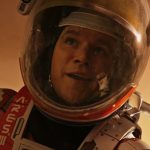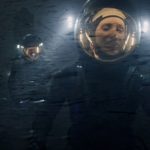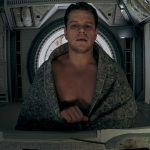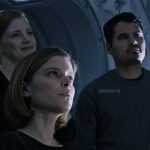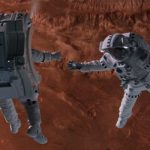The Martian – 2015
I really liked this movie, and for the same reason I liked the 2009 Best Picture nominee, Gravity. They made a real effort to pay attention to the science which gave the movie an innate realism that many science fiction films lack. I mean, sure, when making a sci-fi movie, you can generally make up your own rules as long as you adhere to what you make up. But it is the movies that are grounded in reality that are the most fascinating because you know that the film is a step closer to reality.
The Martian is about Mark Watney, played by Matt Damon, an astronaut on a manned mission to Mars. As he and his team are doing surface surveys, a Martian storm arises and proceeds to batter the scientists with dust, dirt, and scientific equipment. Mark is hit by debris and gets lost in the storm. Thinking him dead, his crewmates abort their mission, leave the planet’s surface, and start their long voyage back to Earth. Meanwhile, Mark has survived the ordeal, and must now struggle to survive alone on the alien world until the next mission to Mars arrives.
OK, lets pause here for a moment to do a little backtracking. I know I just got done praising the movie for its adherence to actual science, but even as I watched the movie, I knew enough about the Martian environment to know that the storm was a complete fabrication that could never have happened on Mars. You see, the Martian atmosphere is so thin, about 1% as dense as that of Earth, that even a wind that moved at 120 miles per hour would have a weak force. The wind would have to be moving at least 40 miles per to even lift dust from the planet’s surface. I realize that the whole premise of the movie is based on Mark being left behind. The only way this would actually happen is if he was separated from the group and presumed dead. Without that impossible storm, there wouldn’t have been a movie. But alright, nearly everything else was scientifically factual.
The movie follows Mark’s efforts to stay alive. He must learn hos to grow food, create water, generate heat, find a way to communicate with Earth, and stay sane in his isolation. All of this, he does through resourcefulness, hard work, and an incredible intellect. The roll seemed physically demanding and Damon did a fine job. I have always liked him as an actor and I was not disappointed here. Ever since I first noticed him in 1997’s Good Will Hunting, I have always thought his face has a ready look of intelligence, along with a healthy dose of natural charm, both of which are qualities that served his character well.
But the movie also follows two other stories, those of the crew of the Aries III who left him behind, and the NASA scientists who learn he is still alive and attempt to rescue him. The five other astronauts are Commander Lewis, the Captain, Major Martinez, the pilot, Beth Johansen, the Systems Operator, Dr. Beck, the Flight Surgeon, and Dr. Vogel, the Navigator, played by Jessica Chastain, Michael Peña, Kate Mara, Sebastian Stan, and Askel Hennie, respectively. On the ground, there were various NASA administrators, scientists, and politicians, played by Jeff Daniels, Kristin Wigg, Chiwetel Ejiofor, Sean Bean, Mackenzie Davis, Donald Glover, and Benedict Wong.
Of the three stories, Watney’s was the most interesting, of course. His ingenuity led him to use the human feces of the departed crew to fertilize the Martian soil, created water using left over rocket fuel, and a few freeze dried potatoes to create a garden inside an empty habitat structure. He uses a previous mission’s discarded probe to communicate with Earth. He learns to ration his supplies and survive in the harsh environment. Scientists agree that aside from that pesky impossible dust storm, the film is firmly grounded in reality.
Beyond Damon, the actors who stood out to me as a cut above the rest were Chastain, Ejiofor, and Daniels. Commander Lewis is the one who made the decision to leave the planet in order to save the whole crew, not knowing whether Watney was alive or dead. The guilt she felt when she learned that he was still alive was well handled by the actress. There was a constant struggle between Teddy Sanders, the Director of NASA, played by Daniels, and Vincent Kapoor, the Director of Mars Missions, as they try to decide how to handle the situation and mount a rescue attempt. The two almost seemed to be rivals, but they played off of each other well.
I also have to mention the movie’s very cool ending, because it turned the narrative from a tale of survival to a bit of an action sequence. The final rescue was exciting and fraught with danger. The crew does a slingshot around Earth to pick up supplies and speed to return to Mars. They plan an orbital rendezvous with Watney in which he has to rocket himself into space in a pod which he has torn apart to reduce its weight. I mean, I knew the rescue was going to be successful, but I was still cheering when they finally got him into the Aries III. And even in this thrilling climax, the science was still realistic. Director Ridley Scott really did his research to make the whole movie as realistic as possible, and I have to say, he got everything right… well, almost.
